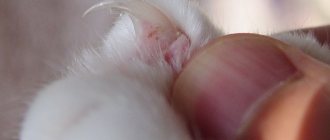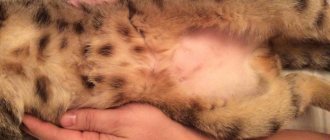How anxiety manifests itself
Stress in a cat can manifest itself in different ways and includes four main reactions.
Nervous behavior
The pet begins to purr and lick itself more often than usual; bald patches may then appear in these places. If there are no parasites on the fur, then such actions indicate overexertion. Sometimes licking is accompanied by a change in appetite - the animal either begins to eat too much or refuses to eat at all.
Trying to hide
The second sign that an animal is experiencing fear is its desire to crawl into a secluded place and not show itself until the irritating factor disappears. Most often, cats are frightened by loud noises, strangers, other four-legged animals, or new habitats.
Aggression
Sometimes, instead of fear, cats experience the opposite reaction - aggression. When in a highly agitated state, they can attack other animals or people. Most often, this reaction is characteristic of males protecting their territory, or females protecting their cubs.
It is not difficult to determine that an animal is in an aggressive state:
- tries to appear larger to others than he really is: fluffs his tail, arches his back;
- makes hissing, snorting and other threatening sounds;
- the pupils narrow, the eyes concentrate on the object of attack;
- the tail twitches with excitement;
- when trying to get closer, the front paws are used.
Panic
The highest stage of manifestation of nervous overexcitation is a panic attack. In this state, the animal emits terrible screams, accompanied by profuse salivation. The fear may be so intense that involuntary urination or defecation occurs. In this case, the ears are pressed firmly to the head, the pupils are dilated, not narrowed. The cat shrinks and presses itself to the ground.
The body language of cats is familiar to many. It is by external manifestations that one can suspect that the pet is stressed, does not feel well or is preparing for an attack:
- a cat twitching its tail is irritated;
- a cat arching its back threatens;
- raised fur, flattened ears, hissing, growling - manifestations “a second before the attack.”
These are clear manifestations of a defensive reaction. It is much more difficult to recognize the hidden aggression of a sick animal. In such cases, the cat simply tries to find a secluded place where no one will disturb it. An attack in such cases is rare, but possible. It is usually provoked by interference with the animal's rest. But even in such cases, the cat will not attack suddenly; it will always make it clear that it does not like what is happening.
Externally, you can tell from a cat that she doesn’t like something about what’s happening.
I had an aggressive cat who did not tolerate loud noises, be it our laughter or the sound of the TV. He rushed like lightning onto our legs, sometimes leaving quite deep wounds there. But before the attack we had a couple of seconds to defend ourselves. The cat walked towards the “victim” with its ears flattened, moving its head from side to side and meowing. If at that moment you threw a pillow or a soft toy at him, the incident could be considered over (well, turn down the sound volume, of course).
Signs of gaming aggression
In fact, there is nothing strange about the aggressive behavior of kittens. Cats are typical predators. In nature, they catch up with prey, dig into it with sharp claws and, with a lightning-fast movement, bite off the cervical vertebrae.
Have you noticed how little kittens behave when they have barely learned to walk? They growl and attack each other, biting and scratching their brothers and sisters. The mother cat also gets a lot. However, as soon as one of the kids gets too carried away with the role of the “evil and scary tiger,” he will immediately be put in his place: his mother will give him a couple of slaps on the wrist, and the brothers and sisters will growl threateningly or, even worse, crawl away about their business. The poor guy can only cry and seek comfort from his mother. This is how the kitten learns to control aggression.
If there is an adult cat in the new home where the kitten ends up, the baby will learn this from his older friend. Calmer and more balanced than a cat, the cat will happily play with the baby. He is not annoyed by the way the kitten sneaks up on him, pressing his tummy to the floor, and attacks him from behind. And you can endlessly watch how the baby selflessly catches the quivering tip of a long tail hanging from the back of the chair, like fire and water. However, as soon as the kitten crosses the thin line that separates play from hunting, the cat will immediately slowly walk towards him, tilting his head and slightly snorting with his nose. Reprisals usually do not follow: the little sly man falls to the floor, raising all four paws in the air in a defeatist gesture.
Thanks to strict control, the kitten quickly learns to control itself and grows up calm and very affectionate. There are also cats that stay with their mother for the rest of their lives.
It's another matter when you find yourself alone with a small kitten. You will have to teach him all the wisdom of life on your own, and this is not always easy. You and your family will get bitten and scratched by needle-sharp claws. Sometimes a person doesn’t have the courage to say a stern “no!” when the baby is intently chewing his finger. It looks so funny! And after a couple of years, seeing that the place on his favorite sofa is occupied by the owner, an adult seasoned cat without hesitation will grab his arm or leg with his teeth.
Looking for a reason
The first step is to understand where the roots of changes in the animal’s behavior come from. In other words, why did the cat become aggressive? What to do and how to restore peace? Most pet fluffies are affectionate and gentle. As soon as you pet the sissy, he will jump on his knees and begin to hum a purring song. It’s a completely different matter if the pet’s behavior is far from ideal, and even the owner tries to avoid it.
Most often, problems begin in your cat's childhood. If he grew up in an atmosphere of warmth and comfort, love and affection, then most likely he will not turn out to be an aggressive cat. What to do if you got your pet as an adult? This is a separate topic. True, this character trait may be due to the characteristics of the breed. For example, Siamese cats are less trainable than all others; Persians and British cats are also stubborn.
The answer to fear
Cats are freedom-loving creatures. And they themselves “decide” when they want affection. If your love and attention came at the wrong time, then the cat may react aggressively - release its claws, bite, or start hitting you with its hind legs.
Some cats snap when they are petted or caressed or simply try to do so. Moreover, this happens both when trying to touch, and after some time.
A similar reaction is also sometimes observed during combing, nail trimming and other grooming procedures. There is no exact explanation for this behavior, but it is likely caused by overstimulation and an attempt by the pet to control the situation.
What to do at home?
In cases where it is not possible to identify the cause of hostile behavior on your own, a number of steps should be taken.
- Take your pet to the veterinarian to rule out dental diseases.
- As recommended by your doctor, use blood tests and ultrasound to rule out or confirm kidney and liver failure.
- After undergoing an X-ray examination, identify the presence of diseases of the musculoskeletal system.
The ideal environment for cats is an opportunity to hide. If she does not have her own house, then an ordinary cardboard box, basket, or carrier can be used as a shelter.
If aggression is associated with behavioral factors, then “first aid” to relieve an attack can be provided by the drug Feliway, which is rightly called a behavior corrector. It contains an artificial analogue of the pheromones secreted by cats in a calm environment, and helps an excited animal quickly calm down.
If the cause of stress is hormonal changes in the animal’s body, then experienced veterinarians suggest changing the diet, reducing the amount of food in one serving, but at the same time increasing the number of feedings.
Insulation
To calm your cat, it is sometimes helpful to isolate it from other animals and irritants. Having allocated a separate room, you need to provide her with the usual food and clean water, and put a heating pad under the bedding. In a hyperactive state, it is not recommended to let your pet outside, much less allow it to contact its relatives.
Music therapy
The beneficial effect of classical music on the emotional state is experienced not only by people, but also by animals, especially sensitive ones like cats.
More attention
As with any restless creature, when stressed, a cat needs extra attention and affection. More often you need to hold her in your arms, massage or stroke her, and also “talk”.
Shock bath
Everyone knows that representatives of the cat family do not like to swim. Therefore, doing this will be the right decision in order to bring him to his senses.
After bathing, the animal will need time to dry and get its fur in order. All these actions are aimed at switching his attention, as a result of which nervousness decreases.
Having faced the aggression of a small predator and having tried its clawed paws and sharp teeth in action, the question inevitably arises of how to prevent or calm the raging pet.
We suggest you read: Ear diseases in cats. Treatment of hematoma in a cat. Symptoms of a hematoma in a cat
When a person takes a cat into his home, he also takes responsibility for this animal. It is impossible without knowledge of cat psychology. A cat is more than just fluffy fur and purring. A pet requires proper care and care for its health.
If a person has not dealt with cats before, he should read about them. There is enough information on the Internet. But as far as your pet’s health is concerned, it is better to consult a veterinarian on this issue. Knowledge of the characteristics of this type of animal and the rules for caring for them can prevent many unpleasant situations in communication.
Only when I had children myself, I realized how important a permanent doctor is, who is familiar with the characteristics of my child and remembers how his illnesses usually progress. A permanent veterinarian is also important for your pet. We changed many clinics, until I chose the one where they treat my charges with respect, although they are mongrel and live in the yard. Here I sterilized them all and gave them vaccinations. the staff already remembers us and knows the names of my cats and dogs.
There are simply no folk remedies for relieving aggression in cats.
There is an opinion that catnip (catnip) calms cats. But this is not so, it rather simply changes the behavior of the animal, attracts attention to itself, but still does not have a calming effect.
Valerian does not have a sedative effect on cats. This is a drug that also further excites the nervous system. Giving it to cats is strictly prohibited. Consuming alcohol solutions can even be fatal.
There are medications to treat aggression in cats:
- Homeopathic: Cat Bayun. Designed to relieve sexual desire and nervousness during sexual hunting in a cat. Facilitates the condition of the cat during estrus. Available in the form of tablets and solution.
- Stop Stress. It affects brain cells, reducing its activity. Available in the form of drops and tablets. The product is strong, but not addictive.
- Fitex. Designed for animals on long trips. It calms the cat well and relieves motion sickness. It contains valerian, but is not addictive and does not have a narcotic effect.
- Amitriptyline - great for anxiety and territory marking;
- Vetranquil - 0.15 ml subcutaneously;
All medications, except for sedatives, also have side effects that can harm your pet if the dosage is incorrect. Therefore, self-treatment of cats is prohibited. If a problem arises, you should contact your veterinarian and act only in accordance with his instructions.
In an emergency
To keep distance
It is permissible to stroke only your cat, but even in this case, caressing may not calm the animal, but anger it. No matter how much the owner wants to support his pet, it is better to leave the cat alone in a confined space (carrier, box, house).
Cats by nature are solitary animals, not pack animals. At times of severe stress, they are guided by instincts, and not by attachments acquired through life.
Like other pets, cats show empathy - they are good at feeling people's emotions.
If the owner is nervous or afraid (for example, before an upcoming operation), the pet begins to become stressed for this reason alone. That’s why sometimes it’s better to entrust an animal to an unfamiliar but absolutely calm person for the duration of the procedures in the clinic.
If talking to your cat out loud is uncomfortable or seems stupid, you can try instilling your good intentions telepathically, focusing on your desire to help rather than harm.
READ How to Calm a Dog or Puppy When They're Mad
An angry cat can cause serious injury to a person despite its small size. It is necessary to minimize violent procedures, and if such cannot be avoided, try to secure the cat in advance (for example, in a special bag) while it is calm.
You need to have patience with representatives of the cat family. It is better to approach the animal over and over again than to go straight ahead, ignoring the pet's warning signs.
If aggressive behavior threatens a person or another animal, you should try to distract the cat. The best means of protection is a spray bottle of water. But it is not always at hand.
Trying to break up amicably is a good strategy. You need to make sure that you are not blocking the animal’s only exit from the room, or start retreating yourself. If the cat is ready to rush, throw the object to the side with maximum noise (a bunch of keys), this will give you time to escape.
Territory defense
In this case, the pet clearly wants to be left alone. He is scared or upset. The best way to calm an aggressive cat is to let him sit quietly in his favorite corner. Attempts by the owner to pet, play or give a treat will be regarded by the pet as another encroachment on its safety. If your pet likes to rest in the closet, where the bottom shelf is covered with a soft blanket, then now is the time to let her do so.
The easiest way to recognize a scared cat is:
- She huddles to the floor or huddles in a corner.
- At the same time, the pupils are dilated.
- The cat hisses or growls, but makes no attempt to attack you.
- Ears flattened.
- The pet intimidates you, but looks around and tries to find shelter for itself.
We can conclude that the fluffy beauty is desperately afraid of something, so the cat behaves aggressively. What should the owner do? As mentioned above, let him be alone, in a closed and dark corner, on a soft and warm bedding. In some cases, the cat may roll over onto its back and fold its paws. It is very important to recognize this condition so as not to suffer yourself or harm your pet.
This applies mostly to uncastrated cats that are entering puberty. What to do if the cat becomes aggressive and bites? The recommendation is the same: pay close attention to your pet and try to understand what is happening to it. In young individuals, hormones are most often raging, and the aggression associated with dividing territory is very pronounced.
If a cat returns from a walk and shows fighting spirit, most likely he just got into a fight with a neighbor and is not yet cooled down from the fight. Your pet may just need these walks, where he can communicate with his own kind and try his hand at it. Often a cat changes behavior if a new relative appears in the yard.
There can be competition at home, too, if you get yourself a new pet. It doesn't matter if it's a puppy or a kitten. Animals react in a similar way to the appearance of a child, and aggression can be both direct and hidden. In one case, the pet arches its back, hisses and bites. In another, it may mark the territory occupied by the “occupier.”
"Evil" by nature
Let’s make a reservation in advance, cats that show idiopathic (unexplained) aggression are not “bad”; they get along quite well with people, with a reasonable approach to education. The list of "evil" includes:
- Siamese cats have an innate “cult of the owner.” Considering the age of the breed and the history of its breeding, the scratching Siamese is still “flowers”. It is believed that the ancestors of Siamese cats killed people who tried to lie to the pharaohs. Most often, problems arise due to jealousy of the owner, that is, the cat loves one family member, and attacks others.
- White cats – presumably, aggression is associated with “Angora blood”. Most white Angoras are born deaf, which makes them more vulnerable. Fear and self-preservation instincts force the cat to show excessive hostility “just in case.”
- Blue cats - the only assumption that justifies "evil" is the natural distrust that most representatives of this color have. The person shows excessive persistence, which frightens the cat.
Cats that have experienced abuse are also at risk. Abnormal aggression is extremely rare, but it is almost impossible to stop. The owners cannot predict the behavior of the ward; now she purrs and caresses, and a second later, as if at the flick of a switch, she flies into a rage.
When purchasing an animal from a “risk group”, you should carefully weigh your strengths; sometimes, adjusting behavior does not help and the owner has only one option - sedatives for cats in case of aggression. Before starting treatment, read the article to the end. Most types of aggression are understandable and can be stopped. Generally speaking, an animal can become angry for 3 reasons - competition, pain or fear.
Folk remedies
Often traditional methods of treatment alleviate the condition, but not for long. In addition, some of the products may be harmful to the health of the animal:
- Butter - spread it on the face. Instinctively, the cat will begin to lick the substance that it feels on the fur, and will do this until it calms down.
- Take baking soda on the tip of a knife and add it to the milk, then pour it into a bowl.
- Pharmaceutical herbs: chamomile, lemon balm, mint, also have a beneficial effect on restoring the pet’s nervous system. Methods for preparing each of them are written on the packaging.
- Diphenhydramine and valerian are popular remedies in the past. This combination can have a calming effect. However, valerian can be harmful! It is not recommended to give it.
Irritation
Remember yourself when you come home after a hard day. The boss scolded me, there was a difficult client, and in the evening the conductor on the bus was rude. Of course, there is something to be irritated about. This happens with a cat too. At the same time, you can see how the pet suddenly changes. For example, you are petting a cat, and suddenly his calm reaction turns into a hiss? There are no apparent reasons, but the pet is ready to attack anything that happens to be nearby.
We suggest you read: How to calm a cat if she asks for a cat
What should you do if your cat becomes aggressive so suddenly? Assess your pet's condition. If he suddenly starts beating his tail on the floor, it means you need to leave your pet alone. Sometimes, in response to measured stroking, the pet begins to frantically beat the owner with its paws. There is no need to shout at him, much less hit him - everyone is in a bad mood.
It is noteworthy that aggression arising from irritation is most often temporary and suppressed. The cat clearly does not want to harm its owner. It lunges at a person, but the claws are hidden, and there are practically no bite marks left. What to do if the cat is angry and aggressive? We need to let her come to her senses. It's best to do nothing for now.
Unmotivated aggression
The most mysterious type of aggression.
The cat seems to have just rubbed against your legs, purring, accepting your affection, and suddenly suddenly changes its mood and bites you. There is a very fine line when pleasure turns into irritation. Some scientists believe that a person accidentally touches some sensitive place on the cat's body or that static electricity accumulates on the fur from your stroking.
What to do?
Notice a change in mood in time: twitching of the tail, flattened ears, restlessness. It would be good to distract the cat at this moment, for example, with a toy or treat. But if you don’t have time, you’ll have to cover the bite site with disinfectants. There is no other way out in this case.
A game
Most often this is a feature of the behavior of small kittens. Nature has it in such a way that fluffy balls play out life situations. This applies to fights and defending their territory, but at home, grown-up pets sometimes don’t mind frolicking like little ones.
Aggression can be caused by increased playfulness. The distinctive feature is suddenness. If your pet jumps on you from around the corner, starts hissing and extends its claws, then most likely it is just bored and wants to have fun. He can run sideways around the room, brake sharply, snort and bounce like a ball.
Redirected aggression
This type of aggression is very difficult to identify, since it requires good knowledge of the pet’s character and analysis of its behavior. The meaning of redirected aggression is to move the reaction from a stimulus that is inaccessible to the pet to an intermediary object that costs nothing to reach.
Redirected aggression allows the cat to cope with pent-up tension and let off steam.
Many owners have noticed with what interest the cat watches the birds landing on branches and flying away. Sometimes the pet even makes typical hunting movements - swings its paw, jumps. It seems that he is all in the process of chasing... imaginary birds. The window does not allow the cat to realize its hunting instincts and leaves it in a state of frustration.
Often the reason for aggression is what is happening outside the window, be it a missed bird or an unbeaten neighbor's cat.
A similar scenario occurs if your pet sees a cat in the yard with whom he wants to settle scores. The need for release does not disappear anywhere, and here, very opportunely, the owner turns up, whose leg the four-legged friend grabs onto. This “consolation prize” could be another animal in the house, wallpaper, or sofa upholstery. In this situation, it is easy to see how territorial and redirected aggression are intertwined.
What can the owner do?
The only thing the owner can do is understand and forgive his pet. Home conditions inevitably involve daily doses of “frustration,” which cats put up with as best they can.
At home, cats have to periodically suppress themselves, limiting the instincts of the hunter
What can we say, redirected aggression in a slightly modified form is also characteristic of humans. The very need for relaxation is extremely important - if the owner begins to respond to aggression with aggression, the cat will fall into a depressed state.
What to do when stress is planned and inevitable
Before planned stress (moving, bringing a new pet into your home), you should start giving your pet sedatives prescribed by a veterinarian in advance. The effect of hormonal drugs, for example, is cumulative. It will not be possible to achieve the desired effect in two or three days.
If you have already had a sad experience of traveling with a pet (for example, the animal took a long time to come to its senses after a trip), then you should consult a veterinarian about the use of more potent drugs. You cannot give them to an animal yourself. The veterinarian will ask you what exactly the problem was and, based on this, will select the best option for the remedy.
A visit to the veterinary clinic, going on vacation with the owner, or moving to another place are all situations that can make your cat nervous. To help the animal tolerate them more easily, a little preparation is necessary.
To move an animal from one room to another, it is better to purchase a carrier. It must correspond to the size of the animal, the floor is covered with warm material, for example, a blanket. You can also cover the top of the portable cage with either a cloth or, if it is cold, a blanket.
The carrier will ensure the safety of both the pet and the owner. After all, if an animal is in your hands, then, frightened, it can scratch a person, or even worse, break free and run away so that it will be difficult to find.
The range of sedatives is very wide; you can buy any without a prescription at a veterinary pharmacy. The most common ones include: Kot-Bayun, Phytex, Stop-stress drops.
Dry food manufacturers have provided a special diet for cats that may find themselves in a stressful situation. In such cases, nutritional therapy begins ten days before the planned event and continues for two months. The best supplements are Kalm (manufactured by Royal Canin) and Urinari Stress (manufactured by Hills).
When can you use sedatives on your cat?
Cats are amazing creatures with sensitive nervous systems. For them, the cause of stress and the development of neurosis can be a change in their usual environment, especially at a young age, as well as puberty. Often cats begin to show aggression if a new pet appears in the house. The reason for stress in furry animals can be childbirth and the period after birth, associated with the fear of losing kittens. Sedatives have a cumulative effect, and to prevent the occurrence of an unpleasant condition, the cat should be given the drug two weeks before the intended trip.
Sedatives should be given to cats with caution. In some cases, the use of a natural-based sedative may be sufficient; in other situations, the use of chemicals or tranquilizers is required, which must be prescribed by a veterinarian
Symptoms of increased anxiety in a cat include frequent licking of fur and marking territory, aggression towards the owner, family members and oneself, hyperactivity, obsessive movements of the tail, head or paws. A cat's nervous state may be indicated by constant meowing, tearing out fur or sucking tissue, a fixed gaze, gluttony followed by vomiting, and hunting for non-existent prey.
The use of sedatives can reduce stress in your pet and make a difficult period for him more harmless and easily overcome.
Cats are given sedatives for:
- change of place of residence. Cats do not tolerate changes in their environment or home. This is stressful for them, and it takes them some time to adapt to their new place of residence;
- fears and increased anxiety. The cause of excessive nervousness is noisy guests, small children who run after the cat and want to play with it. A cat that can barely tolerate the affection of its owner, with fear and hostility, succumbs to the sometimes unkind stroking of strangers. She doesn’t understand what’s going on around her, what these strangers want, and she develops fears and anxiety. In this case, a sedative is an excellent way to prevent depression in a pet.
- nervous disorders. In some cases, cats experience a progressive nervous or mental disorder without clearly defined causes. In addition to the other characteristic symptoms mentioned above, the pet may experience involuntary head twitching and sudden jumps. Such disorders require examination at a veterinary clinic and the use of not only sedatives, but also medicinal drugs;
- participation in exhibitions, visits to a grooming salon and a veterinarian, vaccinations. Preliminary intake of sedative drops or tablets will allow you to organize the proposed activities more painlessly and without damage to the cat’s nervous system;
- intensive marking of the apartment territory by the cat. Certain sedatives help reduce the desire of cats to leave marks on all corners throughout the apartment, and also suppress the hormonal explosion.
When traveling by car or bus
Moving in any type of vehicle is extremely stressful for a cat. The reasons for depression in pets are a large number of unfamiliar people, unusual smells, noise, hum, and shocks in transport. Panic can also be caused by the owner’s nervous state associated with a long journey, because cats are able to detect mood changes and anxiety in their loved one.
During the flight
It is not recommended to sedate your cat before a flight without the advice of a veterinarian, as this will lead to a decrease in blood pressure, which is dangerous during the flight. When flying with a cat, you can use Feliway, which helps reduce anxiety in cats. Buprenorphine, Gabapentin and Alprazolam are also effective and are also used to reduce anxiety in cats during travel.
After sterilization
Sterilization causes changes in hormonal levels and causes anxiety and aggressiveness in the pet. This condition is also observed in cats during the period of sexual desire and estrus. Special sedatives help eliminate the symptoms of hypersexuality, depression and irritability as a result of changes in hormonal balance. In this case, experts recommend the use of natural-based drugs.
Aggression as a reaction to pain
Sometimes it is difficult for owners to understand what happened to their affectionate and gentle pet. And even more so, it is not clear what to do if the cat is aggressive towards people. This happens quite rarely. If you have not offended the fluffy beauty, she has no reason to behave this way, however, with the exception of cases when she is experiencing severe and excruciating pain.
This often happens with urolithiasis. The animal begins to react with hostility to any touch and may bite or scratch. What to do if the cat is aggressive and attacks? First you need to consult a doctor and rule out the possibility of illness. In severe pain, the animal perceives almost any action as an attack.
Have a conversation within the family. Cats are very vindictive and remember for a long time if they are hurt. Perhaps one of the children is playing too roughly with your pet, which is why his behavior has changed dramatically.
Causes of aggression in cats: diseases
Often the character of pets changes due to deteriorating health. Be sure to take your pet to the veterinarian: the cause of anger and constant attacks on pets can be:
- ischemic encephalopathy;
- toxoplasmosis;
- hyperthyroidism;
- epilepsy;
- heavy metal poisoning, etc.
Why did the cat become very aggressive, and what to do if the animal attacks its owner? Most often, consultation with a specialist is enough to quickly solve the problem. Remember: irritability and anger can be caused even by a banal hormonal imbalance. If your pet begins to behave aggressively, consider whether spaying, neutering, or therapy by an experienced doctor may be the best option.
Sterilization and its consequences
After castration, cats usually become much calmer. Often this is the determining factor for the owner who decides to undergo surgery. Unfortunately, this is not always true for females. Often a veterinarian is asked that a cat is aggressive after sterilization. What to do in this case? We need to look again at the reasons. There can be three of them:
- Stress factors.
- Internal influences.
- External stimuli.
Very often the animal has pain in the seam, and this seriously affects its behavior. Consult your veterinarian, he will prescribe painkillers. In addition, if a change in hormonal levels is observed, it must be immediately corrected with the help of special medications.
How to relieve aggression in a cat using a drug to regulate sexual heat
Experienced breeders and cat owners solve the problem of sexual heat and associated aggressive behavior in pets with the help of SEX BARRIER drops.
For animal owners, the effectiveness and safety of the drugs they use for their pets is important. The modern composition of SEX BARRIER meets their high requirements.
- SEX BARRIER takes into account the species and gender of the animal
The modern composition takes into account the species characteristics of cats, as well as their gender. This allows you to effectively eliminate aggression in a cat and all undesirable manifestations of the period of sexual heat, ensuring safety in using the drug.
A humane solution to aggressive behavior
The use of SEX BARRIER allows you to avoid cat castration surgery, after which he may continue to show aggression. Delicate correction of hormonal levels
The drug contains two analogues of natural sex hormones. Due to this, the dosage of active ingredients in the drug is reduced tens of times compared to drugs containing one hormone. The unique composition of SEX BARRIER also ensures its high efficiency and safety when used by aggressive cats.
Pregnancy and childbirth
When a cat bears kittens, her character gradually changes. In the early stages of pregnancy, she becomes very affectionate and constantly wants to spend time with her owner, but closer to giving birth, everything changes. The animal begins to look for a cozy corner to be alone. The cat is aggressive and won't let you brush it. What to do? It is best to leave her alone and let her lie in the “nest”. After some time, she herself will come to you to pamper herself.
It is important to remember that any loud sounds can traumatize your cat’s psyche, so you need to create silence and give your pet the opportunity to rest peacefully. In this case, the condition usually levels out. Sometimes the veterinarian additionally prescribes special medications that will relieve irritability and improve the condition - these are pheromones, catnip, anxiolytics. It is recommended to use them only under the supervision of a doctor, especially if you have a pregnant or lactating cat.
If she has recently become the mother of furballs, she will try to protect them as much as possible from the outside world. The best thing you can do is not to look into the house or do it very carefully, and only when mom has gone out to eat. You'll have plenty of time to get to know the babies when they're a little older, so don't stress the animal out too much.
The answer to fear
It can occur periodically in cats of any breed and at any age. They may be frightened by people, animals, objects, sounds, objects. For example, a hairdryer or vacuum cleaner, loud music, a doorbell, unexpected laughter, etc.
In certain situations, your pet feels cornered and defends itself if there is no way to escape. This often happens when a cat encounters an unfamiliar animal, person, or even noise. Although sometimes the owners can be frightening.
We invite you to familiarize yourself with: Ceftriaxone for use in cats
Another possible situation is events associated with less than pleasant experiences, such as a visit to the veterinarian.
How to calm an aggressive cat
| Breed | Features of behavior |
| Siamese | Born owners. Can easily become jealous of the owner and get angry because of this |
| Blue | They are quite nervous and timid, so they quickly turn to inappropriate defensive actions. |
| White Angora | Congenital deafness is one of the characteristics of the breed. Because of this, instincts are very developed, including hunting and protective. |
We suggest you read: Treatment of papilloma in cows on the udder treatment
Cats that have previously been abused are considered aggressive. Unreasonable attacks of anger in animals are very rare. If the cat was lazily lying on the sofa and dozing, and then suddenly turned into an angry fury, then this is a reason to think about a visit to the doctor.
The first thing you need to do is let your pet take his place or set aside a dark corner to rest. Minimize triggers and avoid contact with the cat for as long as necessary to calm the animal. What to do if the cat is aggressive and attacks? Get a towel or blanket to wrap her in to block the threat. You can take a water pistol and use it for protection. Usually it is enough to spray the cat once to bring him to his senses.
After this, try not to irritate the furry creature. Walk slowly and smoothly, talk more quietly. Your pet is also a person whose feelings must be taken into account. If you have a different opinion, then it’s better not to get cats at all, much less dogs. Remember that you must demonstrate goodwill. No physical punishment, immersion in icy water or other extreme measures. This will only make the situation worse.
Euthanasia
The most extreme way to solve the problem is euthanasia. If, despite your care and affection, the medications you take, regular walks and other measures, the animal still continues to hiss and bite, then the veterinarian can offer a radical solution. Perhaps we are talking about a severe mental disorder, which is unlikely to be cured.
What I would like to add here: you should not give the cat to other people in the hope that the problem will be solved. Most likely, it will only get worse, so be completely honest with yourself. You have taken responsibility for the life and health of this animal, and you have to make decisions, no matter how difficult they may be.
Causes of restlessness
There are plenty of reasons for concern for such a small animal. In domestic cats, this is the importunity of children and adolescents, harassment of other pets. A street cat suffers from dogs, cold and hunger, contenders for its territory.
Fear and danger
Fear and danger cause a defensive reaction. When defending itself, the cat first tries to avoid conflict; it will not enter into confrontation. And when it becomes clear that there is nowhere to retreat, the animal goes on the attack.
The cat always shows with its appearance that it is ready to defend itself to the last
The cat is a territorial animal. Its habitat in nature is quite extensive. The invasion of a stranger always causes aggression. After all, this threatens to reduce the amount of food, loss of safety of recreation, and limit the attention of females/males. It’s even more difficult for a cat in an apartment.
She is forced to share small square meters with the rest of the family and pets. Therefore, the appearance of newcomers in the house (no matter whether people or animals) will inevitably lead to aggression, at least at first.
In my yard there lives a very lively, I would even say fighting, cat. Before her appearance, some strange mustaches were constantly “snooping” under the windows. They were apparently scouting an area free of competitors and dogs. This cat also came from somewhere, but she took root, we started feeding her, and she stayed with us forever.
While she was not yet sterilized, male strangers used to come into the yard. But they received such a scolding from her that we never saw them again. Now the cats have lost interest in our yard, but still, no, no, someone is checking to see if the space is free. Then I hear terrible sounds under the window. My cat doesn’t even hiss, it’s as if she spits at strangers and rushes towards them with great speed. Sometimes it seems to me that I don’t even need a dog, I already have an excellent guard.
Overexcitement
Overexcited cats rarely result in serious injury for owners. It usually occurs during violent games. Cats are hunters, and this instinct is inherent in them at the genetic level, even if the kitten’s ancestors never caught prey on their own. If overexcited, the cat may strike with its paw or bite lightly. In this way she signals her dissatisfaction. It is enough to simply stop playing and leave the animal alone.
In a state of overexcitation, a cat can injure its owner, but does not do so on purpose.
My mom has a kitten. He is now about 6 months old. When my children play him until he gets overexcited, he stops playing and starts running around the rooms, curtains and, in my opinion, even the ceilings. In this case, it is better to simply get out of the path of his movement, because he runs with his eyes wide and, it seems to me, not on the pads of his paws, but right on his claws. This surge of energy does not last long. The cat just runs out of steam and goes into the bath to lap up the water.
Maternal aggression is defensive in nature. Since this instinct is one of the strongest, its manifestations can be bright to the point of recklessness. The cat will protect its offspring to the last. Of course, in a house where there is trust between the mother cat and the owner, such cases are excluded. Mostly children suffer, as they may accidentally hurt the kitten. The baby's squeak can infuriate the mother, and she, trying to protect the kitten, can rush at the offender.
Maternal instinct is the strongest. the cat will fight to the death, protecting the kittens from the stranger
Disease
A sick animal experiences a whole range of negative feelings: from fear to complete hopelessness. Touching the body and medical procedures cause pain. An animal, feeling its weakness, can only defend itself. Of course, the cat in such a situation will release its claws and bite.
Another reason for aggression is hormonal imbalance. It occurs during the period of sexual hunting as a result of dissatisfaction. And if this happens for years (as in many pets), the pet is guaranteed to become nervous. Moreover, this problem has a recurring nature if it is not solved in radical ways.
What to do? How to prevent or get rid of aggression in a cat?
Friends, we have listed only the main probable causes of aggression, based on them we will try to find a solution to the problem. It is clear that a short article will not replace contacting a specialist, but perhaps it will at least indicate in which direction to look.
1. You need to make sure that the cat is physically healthy and not in pain; for this you will have to contact a veterinarian. If everything is fine with health, we move on.
2. If you are just planning to get an animal, then adopt a kitten at the age of 2-2.5 months, accustomed to feeding on its own. At this age, the kitten has already received enough communication with its mother and with its brothers. Also make sure that it responds appropriately to human touch. He is not afraid of an outstretched hand.
If you are rescuing a stray kitten, be patient and be prepared for aggression
Pay attention to his behavior, if he doesn’t like your stroking, then leave the animal alone, give him time
3. In the room where the cat lives there should be enough space for games, opportunities to hide and relax. This problem is especially acute when there are small children or other animals in the family.
When a cat has nowhere to hide from the annoying attention of other inhabitants of the apartment, this will lead to aggressive behavior. Buy or make a house or a whole play complex with your own hands.
Organize seating areas on the windowsill, under chairs and in other places. Cats are curious animals and love to observe what is happening from a hiding place. Be sure to teach your children how to properly handle animals.
4. Animals that are not castrated are more likely to show aggression, in which case castration (sterilization) is performed. But keep in mind that if aggression is not associated with the manifestation of sexual instincts, then the operation will not have a positive effect.
5. If your cat has a litter, make less fuss around her. There is no need to arrange a viewing, or take kittens into everyone’s arms.
Perhaps it takes time, perhaps she will be loyal to only one family member, more often it is the one who feeds the animal. But there is no need to provoke aggression in any case.
6. Predatory behavior, hunting. Most often, a person himself is to blame for the aggressive behavior of a cat. You need to play with the cat correctly from the very beginning, from the first days of its appearance in the house. You cannot tease with your hands or feet; in general, parts of the body should be prohibited.
Use toys for games: balls, ropes, laces... There should be a place to run, where you can climb and sharpen your claws. Playgrounds and scratch pads are well suited for this.
If the animal is already accustomed to attacking your hands or hunting for your legs, then at least ignore this behavior. Of course if possible. Stop running, waving your arms and shouting, this will only increase the excitement of your hunter. Redirect energy into toys and outdoor play, but you should not be the object of play
It is important to explain to everyone at home about the rules of playing with animals, otherwise retraining will not work
7. If it is impossible to solve the problem of aggressive behavior, regularly trim the cat’s claws to reduce injuries during an attack.
What to do if you have hormonal imbalances
In case of hormonal imbalances, you can use hormonal drugs designed to reduce sexual desire. One of these drugs is “Sex Barrier”, it reduces sexual arousal, but only a veterinarian can prescribe such drugs.
The use of hormonal drugs has a temporary effect, and can also negatively affect the health of the pet. Therefore, using them regularly is not recommended. A radical method for solving problems is castration and sterilization of the animal.
It is important to remember that aggression in a cat does not arise out of nowhere. Only by understanding the reasons can you solve the problem of this behavior. If episodes of aggression occur, it is better to immediately contact a veterinarian, because the animal’s anxiety may be caused by a disease. If there is planned stress caused by moving or the arrival of a new pet or family member, it is better to consult with a veterinarian in advance about the need to take sedatives.
Signs of aggression in cats: how to understand that a cat is preparing to attack?
Owners of aggressive cats are familiar with the manifestations of the difficult character of their pets. The result of aggressive behavior is bitten hands and scratched legs. People often fall under the hot paw of a four-legged aggressor. Let's find out what cat behavior precedes an attack?
In case of aggression towards an animal or a cat person:
- Hiss and growl
- Hit with paw
- Rising of fur (piloerection)
- Approaching in a tense position with an arched back
- They fall to the ground with a rumbling sound
There are various reasons behind the aggressive behavior of a mature cat, for example, lack of experience in communicating with relatives or unsatisfied sexual desire. In order to figure out how to relieve aggression in a cat, you need to understand why the animal shows it.











